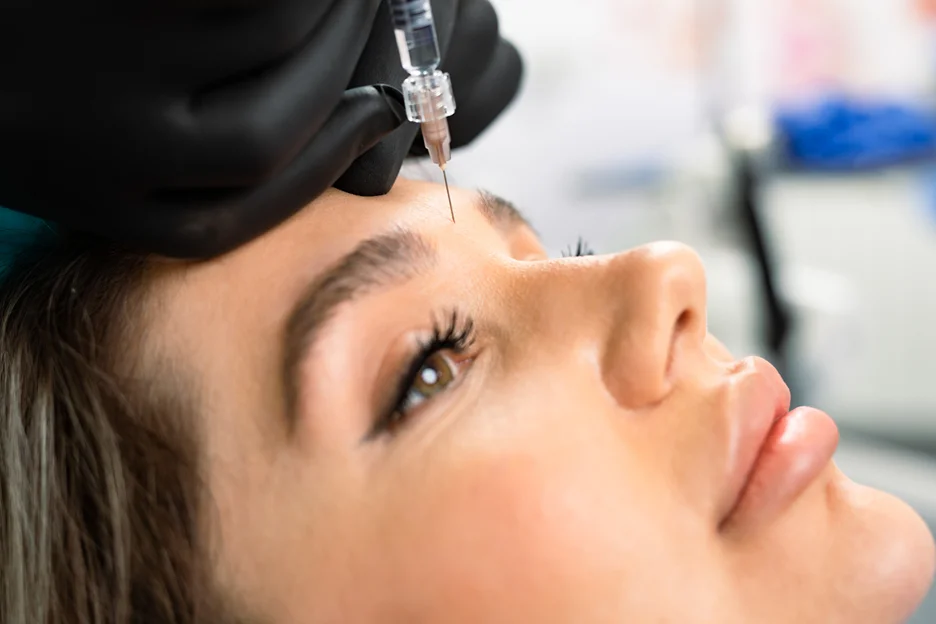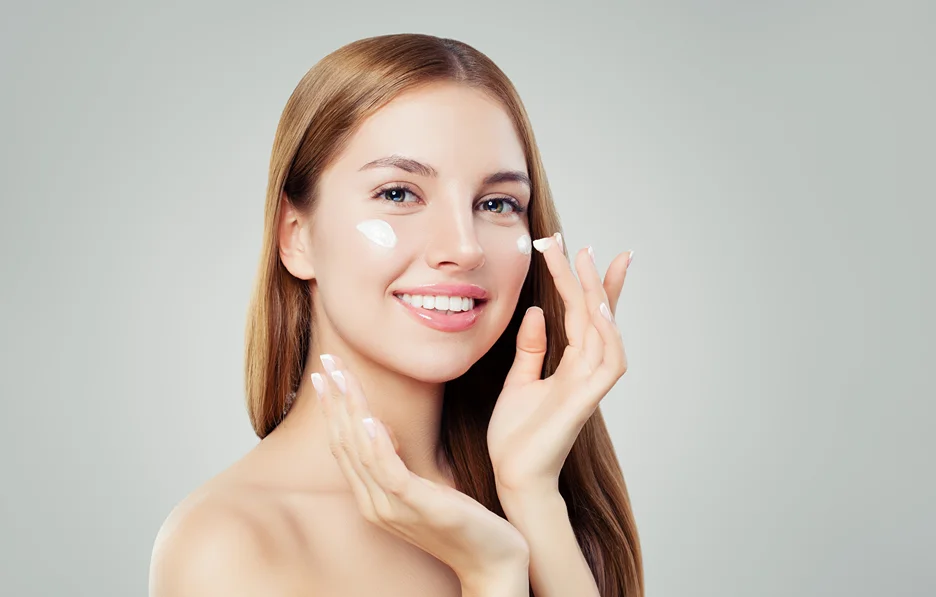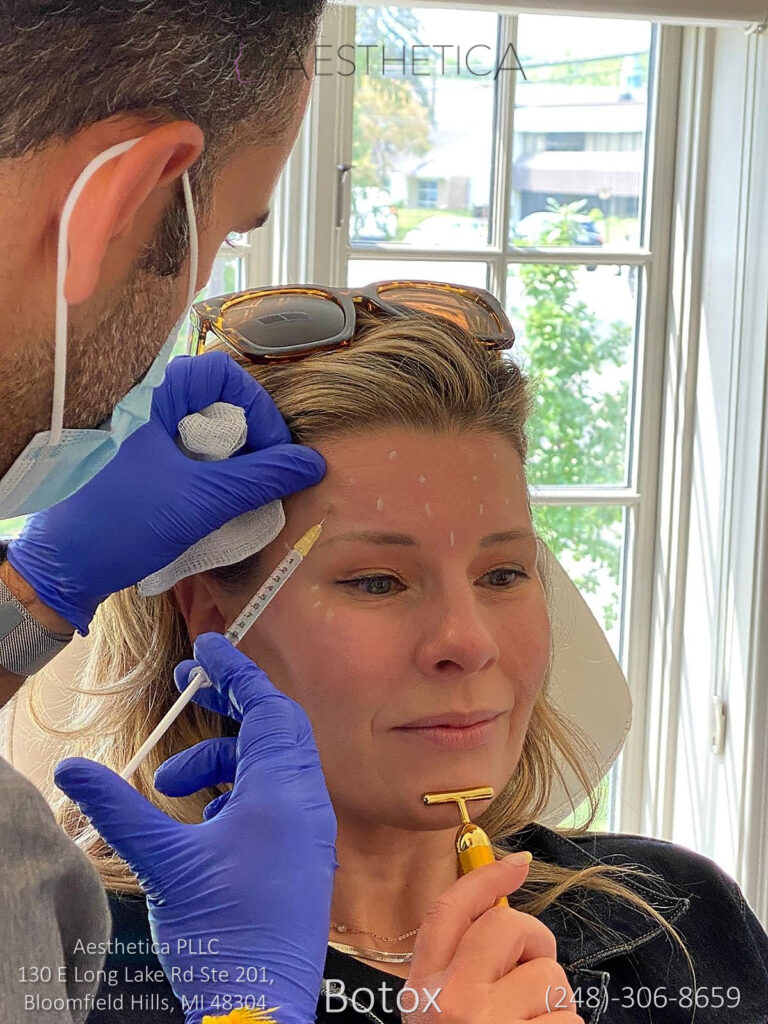
The sensation of sweating can cause severe anxiety for the estimated 15 million people who suffer from hyperhidrosis, a generally undiagnosed medical condition in which the sweat glands on the body are overactive for the majority of the day. Unfortunately, medications aren't always an option for patients, nor are electrical-based skin treatments, which is why many providers use Botox for excessive sweat reduction in problematic areas.
So how long does Botox for hyperhidrosis take to work? Botox can help to stop or at least considerably lessen the symptoms of hyperhidrosis. The effects of the botulinum toxin injection treatment usually occurs within 2 weeks of treatment and can last anywhere from 3 to 6 months. As the nerves regenerate, follow up Botox sessions are usually required in 4 to 6 months. But in the long run, patients can go longer between treatments.
Aesthetica can assist you with all your beauty needs, helping you achieve your maximum beauty and aesthetic potential. Call or contact us today to learn more about our cosmetic services.
After undergoing Botox treatment, you can immediately resume your daily activities. It normally takes 2 to 4 days to see benefits and 2 weeks for the Botox injections to completely take effect. The effects of botulinum toxin are gradual and rarely immediately noticeable. Botox functions at a very specific level in which the nerves meet the muscle, and the process takes a long time to complete.
Botox only has a short-term effect, so you'll need additional injections in the future. Booster injections for excessive underarm sweating are usually required every 7 to 16 months. The effects of treatment on the hands and feet may not stay as long, and patients may need to have Botox reapplied after about 6 months.
Commonly used to address cosmetic wrinkles or perform brow lifts, Botox is also an effective treatment for focal hyperhidrosis. Botulinum toxin injections inhibit the nerve signals or neurotransmitters that cause severe sweating, thus stopping the overactive sweat glands and puts excessive perspiration under control. In contrast with topical antiperspirants, Botox is injected in trouble spots such as the forehead, hairlines, or the back of the neck.
In the underarm area, Botox injection treatment has no effect on touch or sensation. Botox treatments for underarm excessive sweating also only require one clinic visit. In most cases, 25 injections are given in each armpit. With an incredibly small needle, a dermatologist injects a small amount of Botox just beneath the surface of the skin each time.
According to an article published by the International Hyperhidrosis Society, studies have indicated that Botox can reduce excessive underarm sweating by 82 to 87%. Botox injections are most effective in candidates who suffer from focal hyperhidrosis, such as axillary hyperhidrosis (excessive underarm sweat) or palmar hyperhidrosis (sweaty palms).
Excessive perspiration should be examined by a healthcare professional because there are a few potentially rare, severe disorders that can produce symptoms of excessive sweat production. A dermatologist will also consult with patients about their professional and lifestyle demands before prescribing Botox because it can cause muscle weakness in the hands.
After being broken down by the body's normal metabolic process, Botox will eventually lose its capacity to relax muscles. The deeper muscles in the treatment area regain their capacity to contract at this period, allowing sweat to reappear. The treatment area for excess sweating will gradually revert to its original condition.
The effects of Botox injection treatment vary from person to person, but they usually last 3 to 6 months. Botox wear-off speed is affected by a number of factors, including:
The rate of the body's metabolism is the most important aspect in determining how long Botox will last for a patient. The rate at which Botox is processed depends on your individual body chemistry. The effects of botulinum toxin injection treatments usually last 3 to 6 months. However, Botox metabolizes faster in a patient who has a higher metabolism than those with a low metabolism, so their results may last shorter than usual.
Botox results can be influenced by the amount of physical activity you engage in. Athletes may observe that the effects of Botox injections disappear more rapidly. The metabolic rate of an athlete is much higher than the rate of sedentary people. Generally, active bodies heal faster and metabolize Botox from their bodies more quickly.
In order to ensure the maximum effectiveness, a patient with particularly thick muscular features will require additional Botox injections. Because thicker muscular features are more challenging to activate with injections, additional injections are provided to guarantee that the same safety standards are fulfilled.
Another aspect that influences the effectiveness of Botox is the muscle being treated. Because you are constantly moving throughout the day, Botox and other neuromodulators wear off more rapidly in the muscles that are used often, such as the hands or feet. Additionally, the stronger the muscles are in the area of treatment, the faster the effects will subside.
It's impossible to create a standard Botox procedure that will work for everyone. Every treatment of botulinum toxin should be adapted to the level of activity, strength, the severity of their medical condition, and mass of your muscles. Smaller doses, as well as injections administered in constantly moving parts of the body, typically wear off sooner than higher doses. More units of Botox are required for muscles with more size and strength.
The injector's skill is a vital component that can influence the results of Botox injections. If botulinum toxin is injected too deep, it could puncture a blood vessel, resulting in skin bruising. But if Botox is administered too shallowly, it could result in noticeable lines or bumps on the skin. For this reason, it’s important that you only receive Botox injections for hyperhidrosis treatment from a highly-skilled cosmetic dermatologist.
One factor that could have a good impact on the results of Botox treatment is repetition. This is because repeated injections inhibit the overactive sweat glands, allowing the effects of the injections to endure longer. As a result, making regular appointments with a board-certified provider can help you reach your long-term goals of eliminating excessive perspiration.

If you've had Botox injections or are thinking about getting them to eliminate excessive sweating, you already know this procedure is not a long-term solution. Botox usually lasts 3 to 6 months, and we acknowledge your interest in maintaining a sweat-free lifestyle for as long as possible. Here are some suggestions for extending the effectiveness of your Botox for hyperhidrosis treatment.
Maintaining your skin's smoothness requires the use of a high-quality face moisturizer. Collagen and hyaluronic acid-based moisturizers are especially effective since they keep your skin looking firm and healthy while also slowing down the breakdown of Botox in a particular treatment area.
In a study published in the Journal of Drugs in Dermatology, researchers discovered that patients who underwent Botox treatment and subsequently took a 50 mg of zinc supplement saw their results last substantially longer. Over 90% of those who received the supplement rather than the placebo said their initial injections lasted 30% longer.
Smoking, vaping, and everything else containing nicotine breaks down collagen, destroys skin cells, and decreases the effectiveness of Botox injections. In addition to adding to the original dynamic wrinkles, smoking and vaping create wrinkles around the mouth and eyes that can’t be corrected by Botox injections.
Following treatment, abstaining from alcohol for a few days assists in overall healing and maximizes the effectiveness of your injections. Botox injections can occasionally produce drowsiness and dizziness, which doesn't mix well with alcohol.
High-intensity workouts are designed to speed up your metabolism, allowing you to burn more calories and gain muscle faster. You may be forcing your body to digest the Botox more quickly. Strenuous exercises cause Botox to break down quicker than intended, by increasing your metabolic rate.
This isn't to say you shouldn't exercise or even perform intense workouts; it just means you should incorporate more low to moderate-intensity training into your routine.
Sun damage is well known for causing premature aging by damaging collagen and harming skin cells deep inside the dermal layers. The first point to note is that Botox cannot be used to treat wrinkles and lines caused by sun damage, since these wrinkles are not the result of muscle movement. Additionally, UV exposure induces an inflammatory response within the skin cells, which can cause your Botox to break down, limiting its effectiveness and longevity.
The effects of botulinum toxin injection treatments could last anywhere from 3 to 6 months. As a result, retreatment is recommended every 3 to 4 months. However, if your muscles manage to condition themselves to contract less, the duration between treatments could be extended beyond 3 to 4 months. As a result, consulting with a board-certified injector to develop a customized treatment plan is crucial.
People who experience severe sweating face a range of obstacles on a daily basis, including personal and professional limits, ongoing discomfort, and the risk of humiliation, to mention a few. Hyperhidrosis patients are well aware that this one condition has an impact on everything they do. Many patients find excess sweating to be a source of anxiety, since excessive sweat production hinders their daily routine.
Whether you have uncontrollable sweaty palms or armpit sweat, here are other treatment options to help manage focal hyperhidrosis:

The quick and effective results of Botox injections make it a popular treatment for focal hyperhidrosis. You must give the botulinum toxin enough time to take effect, and follow any instructions you receive from your doctor. If you adhere to the aftercare instructions, you will have a sweat-free experience without adverse effects.
Our recommendation is that you follow the advice of your provider so that you can maximize the effects of your Botox treatments. Aesthetica MI provides high-quality and long-lasting Botox treatments, and we address all concerns regarding how to extend the duration of the treatment. Contact us today to schedule a consultation.
Aesthetica can assist you with all your beauty needs, helping you achieve your maximum beauty and aesthetic potential. Call or contact us today to learn more about our cosmetic services.